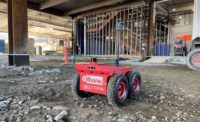Heavy Equipment Gaining Intelligence
Automating human tasks such as bricklaying may fit into the popular image of a robot worker, but roboticization already is creeping into construction tasks that have been mechanized for many years. "The use of robotics in construction is really quite varied," says Jamie Williamson, executive vice president of Topcon Positioning Systems' Precision Automation Group. "You see it from actual surveying at the beginning of a project all the way up through execution of tasks using equipment with automatic controls. We're getting to a point where you're going to take a CAD file, lay it out and build it on the ground."
Some robotic controls are already available for existing construction equipment, but they don't match popular images of robots. Survey equipment manufacturers such as Topcon, Trimble and Leica Geosystems all have had "robotic" total stations on the market for years, performing many of the layout measurements of a traditional survey team member. "It's a one-person survey crew instead of a two-man crew—the site is being automated from the start," says Williamson.
Companies such as Topcon also offer machine control systems for motor graders and other earthmoving equipment, taking control of the blades and buckets out of the operator's hands and entrusting their functions to sensors that check against 3D models.
"With the advent of three-dimensional machine control in the last 10 to 15 years, we've moved into every phase of earth work," said Williamson. "Heavy-equipment manufacturer's are deeply integrating the sensor technologies we provide to more fully automate and take more and more of the decisions out of the operator's hand and make the machine more efficient."
Rather than rush toward autonomous earthmoving equipment, Topcon is focusing on semi-autonomy, with the complex tasks left up to sensors and software. "For an inexperienced operator, operating a bulldozer and keeping it on grade is one of the more difficult tasks he'll encounter," says Williamson. But that changes when the blade's motions are tied to a control system that can correct its position as needed. "You then can use an inexperienced operator who is still able to have good productivity. The machine ends up being a robot from the perspective of grade control."
Growth in use of these control systems has been slow but steady in earthmoving equipment. Williamson estimates that, currently, 30% to 40% of motor graders have some form of automated control system, with a lower adoption rate for bulldozers and only a small percentage of hydraulic excavators. "We expect to see a huge amount of growth, moving forward, on the hydraulic-excavator 3D-control market," says Williamson. "The productivity gains and the reduction in operator fatigue is real. Look at equipment manufacturers—Cat, Deere, Komatsu—they spend millions to get 2% of efficiency improvements. You put a 3D machine automation system in, and we can see 30%, 40% or more improvements in machine productivity."
The ability of machine control systems to communicate to a larger network also can bring benefits. "In real time, a project manager may be in an office on the other side of the world, with design changes that can be delivered to the cab of the machine and translated into directions for the operator and his machine," says Williamson. "There is no question that, at some point, the operator will just be tending the machine as the machine is handling all the repetitive tasks."
Despite these recent advances, Williamson is cautious about the fully robotic construction site. "The goal is completely autonomous operation, but it is a very uncertain time line. A construction jobsite is changing forever." But he says that, in addition to trends such as prefabrication, advanced BIM designs may make jobsites more robot-friendly. "When you use something like BIM and the building is being built on the computer first, solving problems ahead of time, the jobsite may someday just execute those plans."

















